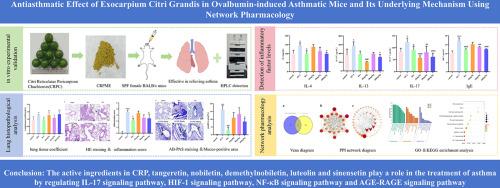Flavonoids from citri reticulatae pericarpium attenuate asthma via IL-17 and NF-κB Pathways: Experimental investigation and network pharmacology
Pharmacological Research - Modern Chinese Medicine
Pub Date : 2025-08-15
DOI:10.1016/j.prmcm.2025.100675
引用次数: 0
Abstract
Background
Citri Reticulatae Pericarpium (CRP), a classic Chinese medicinal herb rich in bioactive compounds, exhibits antioxidant, anti-inflammatory, anticancer, and cardiovascular protective activities. The ethnopharmacological properties of CRP methanol extract (CRPME) may contribute to its efficacy in asthma management. This study investigates the therapeutic effects of CRPME on ovalbumin (OVA)-induced asthma in mice and elucidates its underlying mechanisms using in vivo experiments combined with network pharmacology analysis.
Materials
The major chemical constituents of CRPME were identified via high-performance liquid chromatography (HPLC). We evaluated the impact of CRPME on airway inflammation in OVA-induced asthmatic mice and employed network pharmacology to predict its antiasthmatic mechanisms, providing insights into the molecular basis of CRP's therapeutic potential in asthma.
Results
CRPME significantly alleviated OVA-induced asthmatic symptoms and lung pathological damage, while reducing interleukin (IL)-4, IL-13, and IL-17 levels in bronchoalveolar lavage fluid (BALF) and serum-specific immunoglobulin E (IgE) levels. Network pharmacology analysis revealed that CRPME may exert antiasthmatic effects by regulating IL-17, hypoxia-inducible factor 1 (HIF-1), nuclear factor-κB (NF-κB), and advanced glycation end-product receptor (AGE-RAGE) signaling pathways through active constituents including naringin, hesperidin, demethoxy hesperidin, luteolin, and nobiletin.
Conclusion
Integrating experimental and network pharmacology data, this study demonstrates that bioactive compounds in CRPME mitigate allergic responses in asthmatic mice, supporting its potential as a therapeutic agent for allergic asthma.

柑桔皮黄酮通过IL-17和NF-κB通路减轻哮喘:实验研究和网络药理学
citri Reticulatae Pericarpium (CRP)是一种富含生物活性化合物的经典中草药,具有抗氧化、抗炎、抗癌和心血管保护作用。CRP甲醇提取物(CRPME)的民族药理学特性可能有助于其治疗哮喘的疗效。本研究通过体内实验结合网络药理学分析,探讨了CRPME对卵清蛋白(OVA)诱导的小鼠哮喘的治疗作用,并阐明了其潜在机制。采用高效液相色谱法对其主要化学成分进行了鉴定。我们评估了CRP对ova诱导的哮喘小鼠气道炎症的影响,并利用网络药理学预测其平喘机制,为CRP治疗哮喘潜力的分子基础提供了见解。结果scpme可显著减轻ova引起的哮喘症状和肺病理损害,降低支气管肺泡灌洗液(BALF)中白细胞介素(IL)-4、IL-13、IL-17水平和血清特异性免疫球蛋白E (IgE)水平。网络药理学分析显示,CRPME可能通过柚皮苷、橙皮苷、去甲氧基橙皮苷、木草素和白皮素等活性成分调节IL-17、缺氧诱导因子1 (HIF-1)、核因子κ b (NF-κB)和晚期糖基化终产物受体(AGE-RAGE)信号通路,发挥平喘病作用。结论结合实验和网络药理学数据,本研究表明,CRPME中的生物活性成分可减轻哮喘小鼠的过敏反应,支持其作为变应性哮喘治疗药物的潜力。
本文章由计算机程序翻译,如有差异,请以英文原文为准。
求助全文
约1分钟内获得全文
求助全文

 求助内容:
求助内容: 应助结果提醒方式:
应助结果提醒方式:


